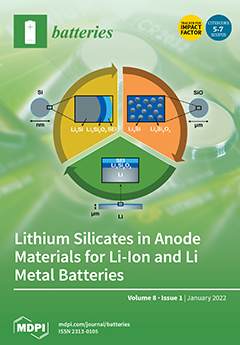Graphite as a commercial anode for lithium-ion batteries has significant safety concerns owing to lithium dendrite growth at low operating voltages. Li
4Ti
5O
12 is a potential candidate to replace graphite as the next-generation anode of lithium-ion batteries. In this
[...] Read more.
Graphite as a commercial anode for lithium-ion batteries has significant safety concerns owing to lithium dendrite growth at low operating voltages. Li
4Ti
5O
12 is a potential candidate to replace graphite as the next-generation anode of lithium-ion batteries. In this work, fluoride-doped Li
4Ti
5O
12 was successfully synthesized with a direct double coating of carbon and nitrogen using a solid-state method followed by the pyrolysis process of polyaniline. X-ray diffraction (XRD) results show that the addition of fluoride is successfully doped to the spinel-type structure of Li
4Ti
5O
12 without any impurities being detected. The carbon and nitrogen coating are distributed on the surface of Li
4Ti
5O
12 particles, as shown in the Scanning Electron Microscopy–Energy Dispersive X-ray Spectroscopy (SEM-EDS) image. The Transmission Electron Microscopy (TEM) image shows a thin layer of carbon coating on the Li
4Ti
5O
12 surface. The fluoride-doped Li
4Ti
5O
12 has the highest specific discharge capacity of 165.38 mAh g
−1 at 0.5 C and capacity fading of 93.51% after 150 cycles compared to other samples, indicating improved electrochemical performance. This is attributed to the synergy between the appropriate amount of carbon and nitrogen coating, which induced a high mobility of electrons and larger crystallite size due to the insertion of fluoride to the spinel-type structure of Li
4Ti
5O
12, enhancing lithium-ion transfer during the insertion/extraction process.
Full article





